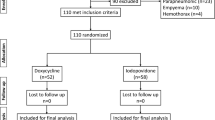Abstract
Background
To evaluate the efficacy of iodopovidone as an agent for pleurodesis in malignant pleural effusion (MPE) and to compare the efficacy of small-bore catheter (Pleuracan, Braun, Melsungen, Germany) and conventional large-bore chest tube in pleural fluid drainage and sclerotherapy.
Methods
Patients with MPE were prospectively consecutively randomized into two groups between August 2004 and February 2007: pleurodesis via conventional (32F) chest tube (group 1) and small-bore catheter (group 2), both using iodopovidone. After 3 months’ follow-up, response rates (complete or partial), complication rates, and duration of procedures within whole group, group 1, and group 2 were compared. Statistical analyses were performed by Mann-Whitney U, χ2, and Fisher’s exact test.
Results
Forty-three pleurodeses were performed in 41 patients. The response was complete in 26 (60.5%) and partial in 12 (27.9%), and the overall success rate was 88.4%. The response rate was not associated with the type of inserted tube (P = .750), pleural fluid pH (P = .290), or pleural fluid lactate dehydrogenase (P = .727). In group 1 (n = 20), 12 demonstrated complete and 6 demonstrated partial response, with a 90% success rate; success was 86.9% in group 2, with complete response in 14 and partial response in 6 patients. Success rates were similar in the two groups (P = 1.000). Of 43 procedures, complications were observed in 14 (32.5%), and complication rates were 35% and 30.4% in groups 1 and 2, respectively (P = .750). The most frequent complication was pain (16.2%), followed by fever, subcutaneous emphysema, dyspnea, and hypotension.
Conclusion
Iodopovidone is an effective, inexpensive, safe, and easily available alternative in chemical pleurodesis in MPE. The success rates of pleurodesis were found to be similar regardless of the type of the tube inserted.
Similar content being viewed by others
References
Parulekar W, Di Primio G, Matzinger F, et al. Use of small-bore versus large-bore chest tubes for treatment of malignant pleural effusions. Chest 2001;120:19–25
Safran L, Ost DE, Fein AM, et al. Outpatient pleurodesis of malignant pleural effusions using a small-bore pigtail catheter. Chest 2000;118:417–21
Keller SM. Current and future therapy for malignant pleural effusion. Chest 1993;103(1 Suppl):63S–7S
Sahn SA. Talc should be used for pleurodesis. Am J Respir Crit Care Med 2000;162:2023–8
Olivares-Torres CA, Laniado-Laborin R, Chavez-Garcia C, et al. Iodopovidone pleurodesis for recurrent pleural effusions. Chest 2002;122:581–3
Light RW. Pleurodesis: what agent should be used? J Pneumologia 2003;29:53–4
Lynch TJ Jr. Management of malignant pleural effusions. Chest 1993;103(4 Suppl):385S–9S
Sahn SA. Pleural diseases related to metastatic malignancies. Eur Respir J 1997;10:1907–13
Agarwal R, Aggarwal AN, Gupta D. Efficacy and safety of iodopovidone pleurodesis through tube thoracostomy. Respirology 2006;11:105–8
Lee GC, Light RW. Management of malignant pleural effusions. Respirology 2004;9:148–56
Agarwal R. Iodopovidone: an inexpensive and effective agent for chemical pleurodesis. Lung Cancer 2007;55:253–4
Lee YCG, Baumann MH, Maskell NA, et al. Pleurodesis practice for malignant pleural effusions in five English-speaking countries. Chest 2003;124:2229–38
Agarwal R, Aggarwal AN, Gupta D, et al. Efficacy and safety of iodopovidone in chemical pleurodesis: a meta-analysis of observational studies. Respirology 2006;100:2043–7
Walker-Renard PB, Vaughan LM, Sahn SA. Chemical pleurodesis for malignant pleural effusions. Ann Intern Med 1994;120:56–64
Heffner JE, Nietert PJ, Barbieri C. Pleural fluid pH as a predictor of pleurodesis failure. Analysis of primary data. Chest 2000;117:87–94
Rodriguez-Panadero F, Antony VB. Pleurodesis: state of the art. Eur Respir J 1997;10:1648–54
Yeginsu A, Karamustafaoglu A, Ozugurlu F, et al. Iodopovidone pleurodesis does not effect thyroid function in normal adults. Interact Cardiovasc Thorac Surg 2007;6:563–4
Author information
Authors and Affiliations
Corresponding author
Rights and permissions
About this article
Cite this article
Caglayan, B., Torun, E., Turan, D. et al. Efficacy of Iodopovidone Pleurodesis and Comparison of Small-Bore Catheter Versus Large-Bore Chest Tube. Ann Surg Oncol 15, 2594–2599 (2008). https://doi.org/10.1245/s10434-008-0004-1
Received:
Revised:
Accepted:
Published:
Issue Date:
DOI: https://doi.org/10.1245/s10434-008-0004-1



